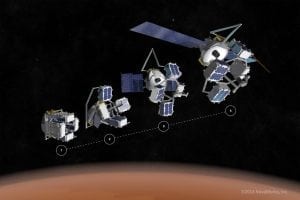Latest News
[Via Satellite 12-11-2014] Spaceflight Inc. has signed NovaWurks as a customer to launch the experimental eXCITe satlets on a 2015 Sherpa mission for the United States Defense Advanced Research Projects Agency (DARPA). NovaWurks is building the modular spacecraft for the agency based on the company’s Hyper-Integrated Satlet, or HISat. Once in space, they can assemble together to create a satellite in orbit. The contract is significant for Spaceflight, which has orbited 76 satellites to date, as it is the inaugural military payload scheduled to fly on a Sherpa.
“This is the first big U.S. government program, by our standards, that has given us the vote of confidence and is going to launch with us,” Curt Blake, president of Spaceflight told Via Satellite. “I think that’s huge because it really opens up a lot of potential for U.S. government customers to get much cheaper launches using rideshare.”
Sherpa employs an oversized Evolved Expendable Launch Vehicle (EELV) Secondary Payload Adapter (ESPA) ring to carry small satellites into Low Earth Orbit (LEO) or Geostationary Transfer Orbit (GTO). The first mission is scheduled to launch in the third quarter of 2015, of which as much as 20 to 25 percent of the mass delivered will be eXCITe satlets. This launch will carry approximately 1,500 kilograms of various small satellites to LEO.
The first Sherpa mission will fly without a propulsion system, but future missions will include this feature, allowing Spaceflight to deliver different satellites to different altitudes according to their mission. Blake said Sherpa is particularly advantageous for popular locations such as Sun-synchronous orbit. The platform does not provide the same level of control as a dedicated small satellite launcher, but it provides much greater flexibility for rideshare customers, he added.
Spaceflight has signed civil government customers such as NASA and the German Space Agency (DLR for its name in German), along with several commercial companies. Blake said the eXCITe contract is not the company’s first military customer overall, but is still a significant step for Spaceflight.
“If you contrast the government as a whole against commercial customers, commercial customers are generally more willing to tolerate risk,” he said, adding that this depends significantly on the size and cost of the spacecraft.
Blake said he does not expect the U.S. government would launch anything they depend on for critical operations using Sherpa at this stage. For the time being, Sherpa is better suited for demonstration missions like eXCITe. Each NovaWurks-built satlet weighs approximately seven kilograms, and has its own power supplies, movement controls, sensors and other components. The satlets are part of DARPA’s Phoenix program, for which NovaWurks received a $30.8 million contract for phase-two and phase-three development. The company won a competitive phase-one contract in June 2012. Applications for the self-assembling, re-purposable eXCITe spacecraft are far-reaching, and are anticipated to drive down the cost of satellites through the use of commercial off-the-shelf technologies.
Sherpa has a second mission planned for 2016 that will head to GTO. Spaceflight plans to have at least two alternating missions — one to LEO and one to GTO —every year following. The company currently has more than 105 spacecraft manifested to launch between now and 2017. As Sherpa gains launch heritage, Blake hopes the company can prove its venerability to gain not only commercial customers, but more military as well.
“Like anything, if this is key to the government’s success in a defense operation, I’m not expecting that they are going to try out something with us that we’ve done once or twice. Frankly as a U.S. citizen I wouldn’t want them to. If it’s critical to our defense I want them to use tried and true, repeatedly tested methods. I think we’re going to be there one day and hopefully we can prove that to them,” he said.
Get the latest Via Satellite news!
Subscribe Now